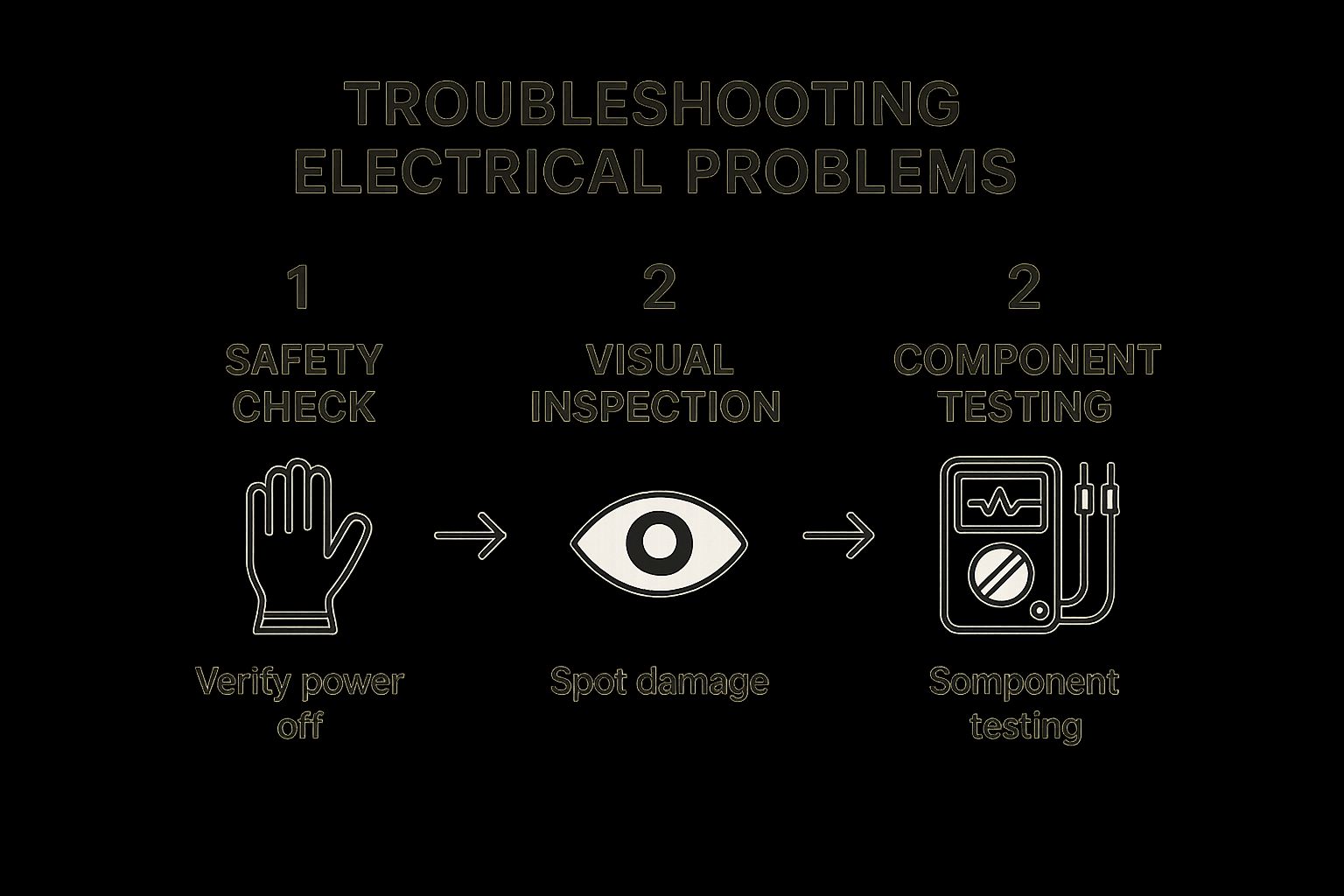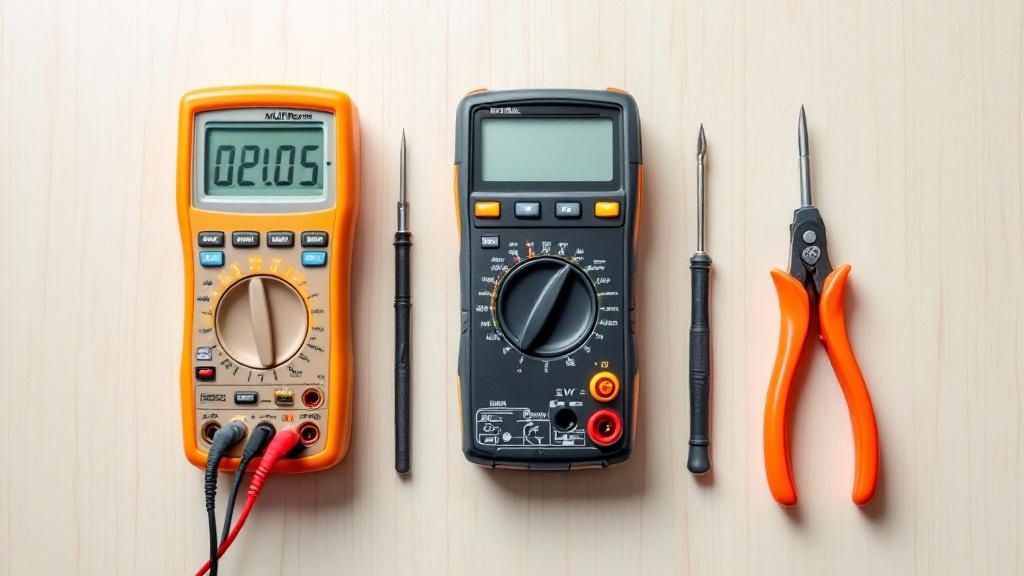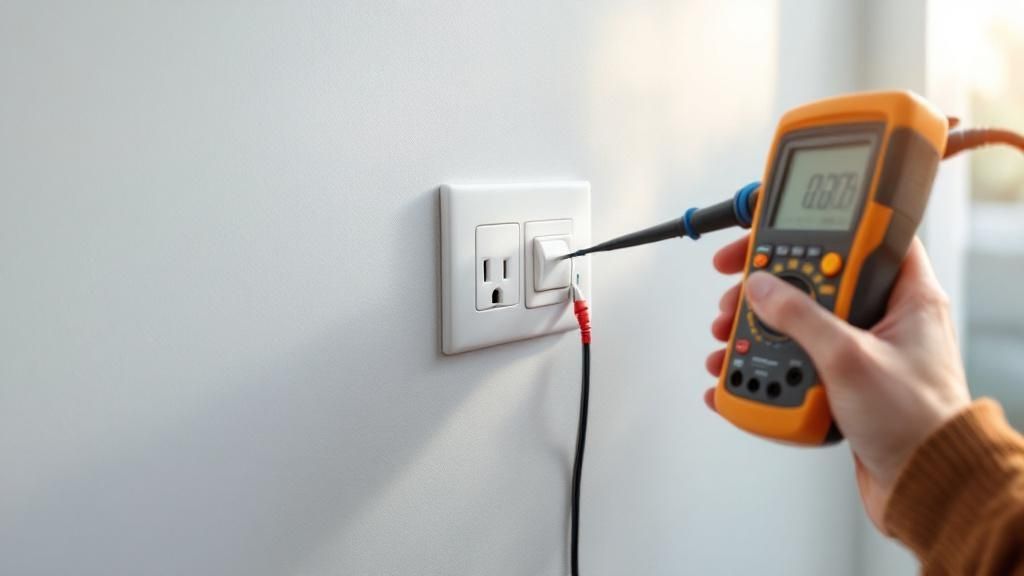So, you've got an electrical issue. Before you even think about grabbing a tool, the first and most critical step is to gather information safely. The goal here isn't to fix anything just yet—it's to figure out what's going on without putting yourself at risk. Is the problem contained to one outlet, or has your whole kitchen gone dark? From there, a quick trip to the circuit breaker panel is usually your next stop.
This methodical approach is what separates a successful diagnosis from a frustrating (and potentially dangerous) guessing game.
Starting Your Electrical Troubleshooting Safely
Let’s be clear: an electrical problem is more than just an annoyance. It’s a potential hazard. Your first moves should always prioritize creating a safe zone before you dive in.
Start by making sure your work area is clear, dry, and well-lit. If you're heading to a damp basement or a cluttered garage, take a moment to clear the space and ensure there's no standing water. I always recommend grabbing a good flashlight, even if it's daytime. You'll be glad you have it when you're peering into the dark corners of a breaker box or behind an appliance.
Assess the Scope and Check the Panel
Your first real clue lies in the scope of the problem. Is it just one flickering light? A single dead outlet? Or is an entire section of your home without power?
A single malfunctioning device often points to a very localized issue—maybe a bad outlet or a tripped GFCI that needs a reset. But if a whole room or floor is out, the culprit is almost always a tripped circuit breaker.
Head over to your electrical panel and take a look. You're searching for a breaker handle that's either flipped to the "off" position or, more commonly, is stuck in the middle. Remember, a tripped breaker is a safety feature doing its job. It has cut the power because it detected a problem, like an overloaded circuit or a fault.
Key Takeaway: A tripped breaker is a symptom, not the cause. It's a clear signal that something on that circuit needs your attention before you just flip the power back on.
This focus on safety isn't just a personal recommendation; it's a global priority. The electrical safety management market is on track to hit USD 6.38 billion by 2032, a testament to a growing awareness of electrical hazards. You can learn more about this industry trend and how it’s shaping regulations.
The workflow for any good troubleshooting job follows a logical path.

This progression—from safety checks to a visual inspection and then to testing individual components—is the safest and most effective way to get to the bottom of an issue.
To streamline this process, I always run through a quick mental checklist. Here’s a table you can use to guide your own initial assessment.
Initial Diagnostic Checklist
Use this quick reference table to guide your initial assessment of any electrical problem and safely gather key information.
This checklist helps you organize your thoughts and ensures you don't miss a basic step before moving on to more complex diagnostics.
When to Immediately Stop
Sometimes, the smartest move is knowing when to stop and call in a professional. If you encounter any of these red flags, your troubleshooting is done. It's time to pick up the phone and call a licensed electrician.
- A burning smell from any outlet, switch, or especially the breaker panel.
- Buzzing or humming sounds coming from the panel or inside your walls.
- Breakers that trip instantly as soon as you try to reset them.
- Scorch marks or any discoloration around an outlet, switch, or fixture.
These signs point to serious and dangerous conditions, like an active short circuit, arcing, or major equipment failure. Honestly, the most valuable troubleshooting skill you can develop is recognizing your own limits. Nothing is more important than your safety.
Figuring Out What's Causing Your Power Problem

Alright, you’ve made sure the area is safe and you’ve had a look at the circuit breaker. Now it’s time to put on your detective hat. Most power problems in a home boil down to a handful of common culprits. Learning to spot them is the key to connecting the symptoms you're seeing to the actual source of the issue.
This isn't just about flipping a switch back on; it’s about understanding why that breaker tripped in the first place. Once you know what to look for, the electrical system itself often gives you all the clues you need.
The Overloaded Circuit Scenario
An overloaded circuit is, by far, the most common headache for homeowners. It’s a simple case of asking a single circuit to do more work than it was built for.
Imagine the circuit is a small country road. When you plug in and run a power-hungry space heater, that’s like a big truck. Then, you decide to start up the vacuum cleaner on that same circuit—that’s another big truck. You’ve just created a traffic jam, and the circuit breaker’s job is to shut down the road before a major accident happens.
You can usually pinpoint an overload by thinking about what was happening right before everything went dark.
- Did the breaker trip the second you fired up the microwave or a hair dryer?
- Were you running a few high-power gadgets in the same room or area?
If the answer is yes, the fix is usually pretty simple. Unplug one of the high-draw appliances and then go reset the breaker. More often than not, that’s all it takes.
Understanding Short Circuits
A short circuit is a different beast altogether—it’s more serious and potentially dangerous. Unlike an overload, which is a matter of too much demand, a short circuit happens when a "hot" wire makes direct contact with a neutral or ground wire. This creates an unintended, super-low-resistance path, causing a massive and instantaneous surge of electricity.
The breaker’s reaction is swift and non-negotiable.
If a breaker trips immediately—the very instant you try to reset it—that’s the classic calling card of a short circuit. Do not keep trying to reset it. This signals a direct fault in the wiring or an appliance that needs to be found and repaired before you can safely restore power.
A real-world example might be a frayed lamp cord hidden behind a couch where the internal wires have finally touched. It could also be faulty wiring inside an appliance or a loose connection that has come apart inside an outlet box.
Your first move is to unplug everything on that circuit. If the breaker then resets and stays on, you know the fault is in one of the devices you just unplugged.
Ground Faults and Arc Faults
A ground fault is a specific kind of short circuit where a hot wire touches a grounded element, like the metal casing of an appliance or a metal electrical box. These are especially risky in damp areas like kitchens, bathrooms, and garages, which is why you see special GFCI (Ground Fault Circuit Interrupter) outlets in those places.
An arc fault is sneakier. This happens when wiring is damaged or loose, causing electricity to jump the gap between wires in a fiery spark, or "arc." This arcing is incredibly hot and a primary cause of electrical fires, which is why newer homes have AFCI (Arc Fault Circuit Interrupter) breakers to detect it.
When you're trying to figure things out, knowing what’s plugged into the circuit is crucial. For instance, specialized equipment often has unique power needs. A good guide on power supplies for CCTV cameras can give you an idea of how these devices behave electrically. By matching the symptoms to these common causes, you can make a much better call on whether this is a quick fix or a job for a pro.
Using a Multimeter for Accurate Diagnostics

When you're ready to stop guessing and start knowing, it's time to grab a multimeter. This is the single most important tool for safely figuring out what’s really going on with your home’s electrical system. We'll skip the heavy electrical theory and jump right into the three practical tests you'll use to solve the vast majority of problems: checking for voltage, resistance, and continuity.
These checks are how you get definitive answers. Is this outlet actually dead? Did that light switch finally give up the ghost? A multimeter turns a frustrating electrical mystery into a solvable problem, giving you the confidence to trace the flow of power and find exactly where it stops. Knowing the difference between a standard multimeter versus clamp meter can also expand your diagnostic capabilities, but for now, we'll focus on the basics.
Confirming a Dead Circuit
Before you even think about touching a wire, you must be 100% certain the power is off. Your eyes and the breaker's position aren't enough—a multimeter is the only way to be sure.
Start by setting your multimeter to measure AC voltage. This setting is usually marked with ACV, V~, or VAC.
Gently insert the red probe into the shorter (hot) slot of an outlet and the black probe into the taller (neutral) slot. A live circuit will show a reading of around 120 volts. If it reads zero, you've likely killed the power to that outlet. But don't stop there.
The Live-Dead-Live Safety TestThis is a non-negotiable safety procedure that I use every single time. It confirms that both you and your meter are functioning correctly.
- Live: Test a known working outlet to confirm your meter reads voltage.
- Dead: Test the circuit you're about to work on to confirm it reads zero.
- Live: Go back and test the known working outlet one more time. This proves your meter didn't fail while you were testing the dead circuit.
Never, ever trust a "zero" reading without this full verification.
Testing Components with Resistance
Once you've confirmed the power is off at the breaker, you can start testing individual components like light switches, fuses, or outlets for internal breaks. For this, we measure resistance, which is measured in ohms (Ω).
Think of it this way: a working part has a clear path for electricity to flow through, which means it has very low resistance. A broken part has a gap in that path, creating infinite resistance.
Let's say you suspect a faulty light switch. After turning off the power and removing the switch from the wall, set your multimeter to the ohms (Ω) setting. Place one probe on each of the screw terminals.
- Switch "ON": The meter should read very close to zero ohms. This means the internal connection is complete.
- Switch "OFF": The meter should read "OL" (overload) or show an infinity symbol. This means the connection is properly broken.
If your switch reads "OL" even when it's flipped to the "ON" position, you've found your problem. The switch is broken inside and needs to be replaced. You can use this exact same logic to test for hidden breaks in appliance power cords or to see if a fuse has blown.
Solving Problems with Outlets and Switches
 Faulty outlets and light switches are hands down the most common electrical headaches you’ll run into around the house. One minute an outlet works fine, the next it’s dead. Maybe a light switch feels spongy or, even more alarming, you see a tiny spark when you plug something in. The good news is that fixing these issues is usually something you can handle yourself if you're methodical and safe.
Faulty outlets and light switches are hands down the most common electrical headaches you’ll run into around the house. One minute an outlet works fine, the next it’s dead. Maybe a light switch feels spongy or, even more alarming, you see a tiny spark when you plug something in. The good news is that fixing these issues is usually something you can handle yourself if you're methodical and safe.
Here's something a lot of people don't know: outlets are often wired in a series, like old-school Christmas lights. This means one loose wire on a single outlet can knock out power to every other outlet down the line on that wall. The real trick is figuring out if you're dealing with a simple loose connection or a device that's just plain worn out.
Pinpointing the Failure Point
Before you grab a screwdriver, think safety first. Always. Go to your breaker box, shut off the correct circuit, and then double-check the outlet with your multimeter to confirm it's dead. Once you’re absolutely certain the power is off, you can get to work.
Carefully remove the faceplate and gently ease the outlet or switch from the electrical box. You're now on a fact-finding mission.
- Loose Connections: Eyeball the screw terminals. Is a wire barely hanging on? That's a classic failure point.
- Physical Damage: Look closely for any black scorch marks around the terminals, melted plastic, or wires with cracked insulation. These are red flags.
- "Back-Stab" Connections: Many outlets use quick push-in wire connections on the back. From my experience, these are notorious for failing over time and are a prime suspect for intermittent problems.
If a wire is just loose, you can often fix it by stripping a fresh bit of copper and securing it firmly under the screw terminal. But if you see any evidence of burning or melting, that device is toast. Don't even think about reusing it—it needs to be replaced immediately.
Pro Tip: If you pull an outlet out and see the wires pushed into the back, do yourself a favor. Take the time to move them to the more reliable screw terminals on the sides. It's a simple upgrade that creates a far safer and more durable connection.
Outlet and Switch Problem Solver
Outlets and switches can fail in a few predictable ways. This table can help you quickly connect the symptom you're seeing with the most likely cause, saving you from chasing ghosts in the walls.
Think of this as your first-pass diagnostic chart. By matching what you see with a probable cause, you can approach the repair with more confidence.
Chasing Downstream Electrical Issues
So what happens when an outlet is completely dead, but you know for a fact the breaker is on? This is a classic downstream problem. The issue isn't with the outlet you're looking at, but with the one "upstream" that feeds it power.
The most common culprit is a tripped GFCI outlet. You know, the ones with the "Test" and "Reset" buttons in kitchens, bathrooms, and garages. These devices are often wired to protect other standard outlets on the same circuit. Before you start dismantling anything, do a quick tour of your house and look for a GFCI that needs to be reset. You’d be amazed how often pressing that one little button brings a dead outlet in a totally different room back to life.
This systematic process—test, inspect, and understand the flow—is the key to effective electrical troubleshooting. It transforms a frustrating mystery into a puzzle you can actually solve.
Knowing When to Call a Professional Electrician
Knowing your way around a circuit breaker is a great skill, but the real mark of a smart homeowner is knowing when to put the tools down and pick up the phone. It's one thing to flip a tripped breaker, but it's another thing entirely to tackle a problem that could put your home and family at risk.
Think of it this way: some electrical issues are more than just a nuisance; they’re alarm bells. If you see, smell, or hear any of these warning signs, it's time to stop troubleshooting immediately and call in a licensed pro.
Non-Negotiable "Call an Electrician Now" Scenarios
- A burning smell from any outlet, switch, or your electrical panel is a major red flag.
- Buzzing or humming noises coming from inside your walls or from the breaker box itself.
- A breaker that trips again instantly after you reset it, even with nothing plugged into that circuit.
- Any sign of water near outlets, switches, or electrical boxes.
These aren't suggestions; they're urgent warnings. A burning smell could signal wires melting behind the wall, and buzzing often points to a dangerous electrical arc. Trying to fix these yourself isn't just risky—it's playing with fire.
The Real Dangers of a Botched Repair
When electrical repairs go wrong, the consequences are severe and often hidden. It's not just about the immediate risk of a shock. A wire that isn't secured perfectly can create a tiny point of high resistance. Over time, this spot can generate incredible heat, creating a serious fire hazard that smolders inside your walls long before you'd ever notice.
On top of the physical danger, unpermitted or improper electrical work can completely void your homeowner's insurance. If a fire does start from your handiwork, you could be left footing the entire bill for the damages.
A professional electrician isn't just there to fix a single issue. They're ensuring your entire system is safe, up to code, and reliable for the long haul. Think of their work as an investment in your peace of mind.
How to Make the Service Call More Effective
When you do call an expert, you can help them solve the problem faster—and save yourself some money. Give them as much detail as you can. Tell them exactly what you observed, what was running when the problem occurred, and what you’ve already tried to do. A clear picture helps them zero in on the root cause much more quickly.
This kind of proactive communication is becoming more common everywhere. In fact, the market for professional electrical equipment monitoring is projected to hit over $3.3 billion by 2030. This trend highlights a major shift from simply reacting to failures to using detailed diagnostics to prevent them. You can read more about this shift toward predictive maintenance to see how experts are getting ahead of problems before they start.
Your Top Electrical Questions, Answered
When you're poking around trying to figure out an electrical issue, the same questions always seem to surface. Knowing the answers helps you draw a clear line between a simple fix and a serious hazard. Let's walk through some of the most common ones I hear from homeowners.
Getting these right is a big part of learning to troubleshoot your home's wiring safely and effectively.
Is It Normal for a Circuit Breaker to Feel Warm?
A breaker that's a bit warm isn't automatically a reason to hit the panic button. When it's working hard—powering a big appliance like an air conditioner or an electric dryer—it's perfectly normal for it to generate a little heat. That's just part of the job.
But there's a big difference between warm and hot. A genuinely hot breaker is a serious red flag. If you touch one and it feels hot, or you hear buzzing or smell something burning coming from the panel, you've got a problem.
This points to a dangerous situation. It could be a bad connection, an overloaded wire, or a breaker that's about to fail completely. If you can do it safely, shut that breaker off immediately and call a licensed electrician. Don't wait.
Why Do My Lights Flicker When an Appliance Turns On?
I get this question all the time. Seeing your lights dim for just a split second when a big appliance with a motor kicks on—think your central air or refrigerator—is usually nothing to worry about. That's just a temporary voltage drop from the huge surge of current the motor needs to get started.
You should start paying closer attention when the flickering gets worse or more frequent. Look out for these signs:
- Constant flickering that seems to happen for no reason.
- Flickering that happens when you plug in something small, like a toaster or a vacuum cleaner.
- Lights that dim way down and stay that way for more than a second or two.
These symptoms could signal a much bigger issue. We could be talking about a loose connection somewhere in the circuit, an overloaded neutral wire, or even a problem with the utility company's main line coming into your house. A pro needs to diagnose these situations.
Can I Replace a Two-Prong Outlet with a Three-Prong Outlet?
This is a huge safety question. The short answer is no—you should never just swap out an old two-prong outlet for a three-prong one unless you have a ground wire in the electrical box. That third, round hole is for the ground connection, which is your safety net. It gives stray electricity a safe path to follow if something goes wrong.
Putting in a three-prong outlet without a ground wire gives you a false sense of security. You think your appliance is grounded, but it's not. This is a major safety hazard and an electrical code violation. An electrician can run a new ground wire for you, but a simpler, code-compliant solution is often to install a GFCI outlet. A GFCI provides shock protection even without a ground wire, making it a smart and safe upgrade for older homes.
Managing job notes from the field can be as tricky as diagnosing a tough electrical fault. With Nora, your techs can just send a voice note, photo, or text on WhatsApp. Our AI instantly turns it into a clear, organized job log. Stop chasing down details and get your invoices out faster. See how Nora can clean up your operations at https://www.getresq.com/nora.



